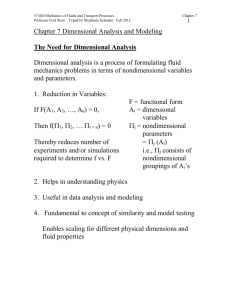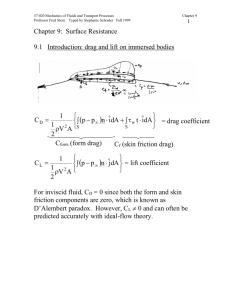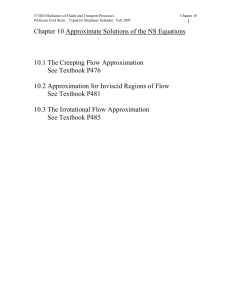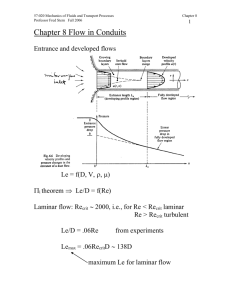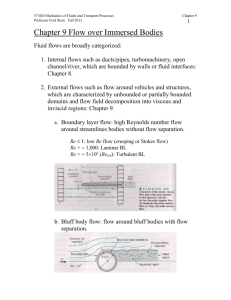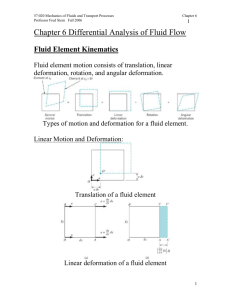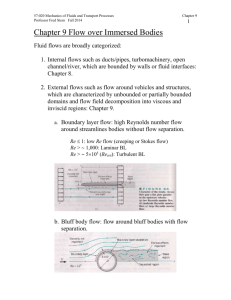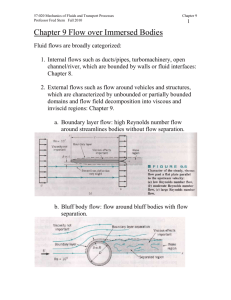theory momentum
advertisement
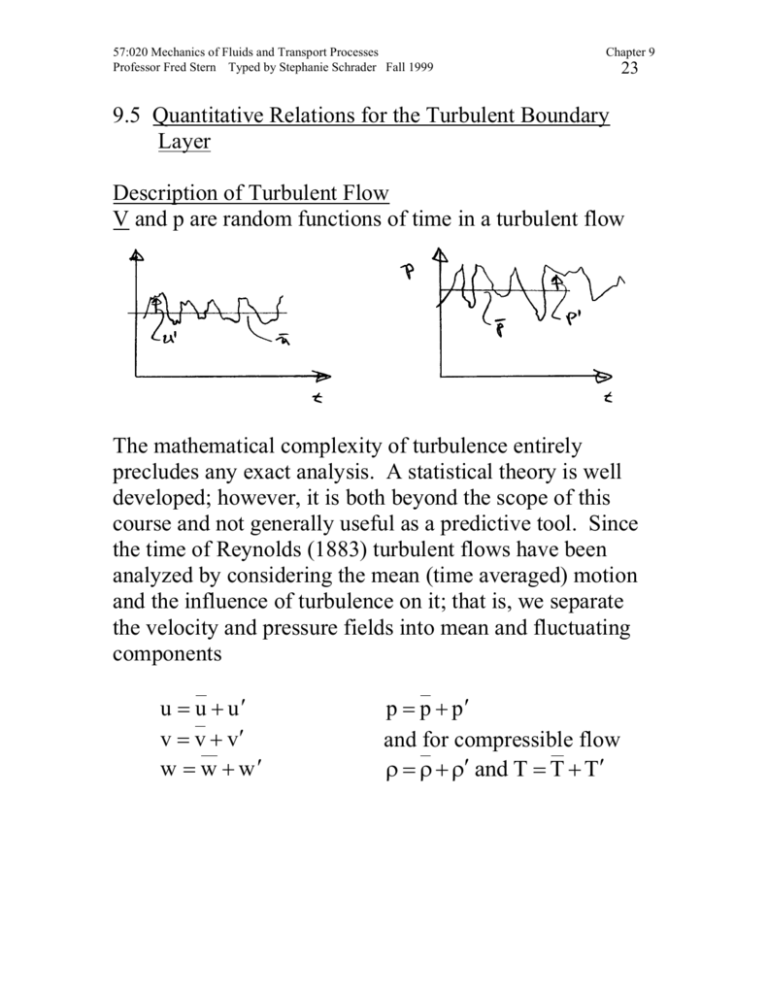
57:020 Mechanics of Fluids and Transport Processes Professor Fred Stern Typed by Stephanie Schrader Fall 1999 Chapter 9 23 9.5 Quantitative Relations for the Turbulent Boundary Layer Description of Turbulent Flow V and p are random functions of time in a turbulent flow The mathematical complexity of turbulence entirely precludes any exact analysis. A statistical theory is well developed; however, it is both beyond the scope of this course and not generally useful as a predictive tool. Since the time of Reynolds (1883) turbulent flows have been analyzed by considering the mean (time averaged) motion and the influence of turbulence on it; that is, we separate the velocity and pressure fields into mean and fluctuating components u u u v v v w w w p p p and for compressible flow and T T T 57:020 Mechanics of Fluids and Transport Processes Professor Fred Stern Typed by Stephanie Schrader Fall 1999 Chapter 9 24 where (for example) and t1sufficiently large that the average is independent of time 1 t 0 t1 u udt t1 t 0 Thus by definition u 0 , etc. Also, note the following rules which apply to two dependent variables f and g f g f g f f f g f g f f s s f = (u, v, w, p) s = (x, y, z, t) fds f ds The most important influence of turbulence on the mean motion is an increase in the fluid stress due to what are called the apparent stresses. Also known as Reynolds stresses: ij u i u j = u 2 u v u w u v v 2 vw u w vw w 2 Symmetric 2nd order tensor 57:020 Mechanics of Fluids and Transport Processes Professor Fred Stern Typed by Stephanie Schrader Fall 1999 Chapter 9 25 The mean-flow equations for turbulent flow are derived by substituting V V V into the Navier-Stokes equations and averaging. The resulting equations, which are called the Reynolds-averaged Navier-Stokes (RANS) equations are: Continuity V 0 i.e. V 0 and V 0 Momentum DV ui uj gk̂ p 2 V Dt x j or DV gk̂ p ij Dt u u j ij i u i u j x j x i ij u1 = u u2 = v u3 = w Comments: 1) equations are for the mean flow 2) differ from laminar equations by Reynolds stress terms = u i u j 3) influence of turbulence is to transport momentum from one point to another in a similar manner as viscosity 4) since u i u j are unknown, the problem is indeterminate: the central problem of turbulent flow analysis is closure! 4 equations and 4 + 6 = 10 unknowns x1 = x x2 = y x3 = z 57:020 Mechanics of Fluids and Transport Processes Professor Fred Stern Typed by Stephanie Schrader Fall 1999 Chapter 9 26 57:020 Mechanics of Fluids and Transport Processes Professor Fred Stern Typed by Stephanie Schrader Fall 1999 Chapter 9 27 2-D Boundary-layer Form of RANS equations u v 0 x y u u pe 2u u v 2 u v x y x y y requires modeling Turbulence Modeling Closure of the turbulent RANS equations require the determination of u v , etc. Historically, two approaches were developed: (a) eddy viscosity theories in which the Reynolds stresses are modeled directly as a function of local geometry and flow conditions; and (b) mean-flow velocity profile correlations which model the mean-flow profile itself. The modern approaches, which are beyond the scope of this class, involve the solution for transport PDE’s for the Reynolds stresses which are solved in conjunction with the momentum equations. (a) eddy-viscosity: theories (mainly used with differential methods) u In analogy with the laminar viscous u v t stress, i.e., t mean-flow rate of strain y The problem is reduced to modeling t, i.e., t = t(x, flow at hand) Various levels of sophistication presently exist in modeling t 57:020 Mechanics of Fluids and Transport Processes Professor Fred Stern Typed by Stephanie Schrader Fall 1999 t Vt L t turbulent length scale turbulent velocity scale Chapter 9 28 where Vt and Lt are based an large scale turbulent motion The total stress is total t u y eddy viscosity (for high Re flow t >> ) molecular viscosity Mixing-length theory (Prandtl, 1920) u v c u 2 u 1 2 v 2 2 v u y based on kinetic theory of gases 1 and 2 are mixing lengths which are analogous to molecular mean free path, but much larger u y u v 2 2 u u y y distance across shear layer Known as a zero equation model since no additional PDE’s are solved, only an algebraic relation y = f(boundary layer, jet, wake, etc.) 57:020 Mechanics of Fluids and Transport Processes Professor Fred Stern Typed by Stephanie Schrader Fall 1999 Chapter 9 29 Although mixing-length theory has provided a very useful tool for engineering analysis, it lacks generality. Therefore, more general methods have been developed. One and two equation models Ck 2 t C = constant k2 = turbulent kinetic energy = u 2 u 2 v 2 w 2 = turbulent dissipation rate Governing PDE’s are derived for k and which contain terms that require additional modeling. Although more general then the zero-equation models, the k- model also has definite limitation; therefore, recent work involves the solution of PDE’s for the Reynolds stresses themselves. Difficulty is that these contain triple correlations that are very difficult to model. 57:020 Mechanics of Fluids and Transport Processes Professor Fred Stern Typed by Stephanie Schrader Fall 1999 Chapter 9 30 (b) mean-flow velocity profile correlations (mainly used with integral methods) As an alternative to modeling the Reynolds stresses one can model mean flow profile directly. For simple 2-D flows this approach is quite food and will be used in this course. For complex and 3-D flows generally not successful. Consider the shape of turbulent velocity profiles. Note that very near the wall laminar must dominate since u i u j = 0 at the wall (y = 0) and in the outer part turbulent stress will dominate. This leads to the three layer concept: Inner layer: viscous stress dominates Outer layer: turbulent stress dominates Overlap layer: both types of stress important 57:020 Mechanics of Fluids and Transport Processes Professor Fred Stern Typed by Stephanie Schrader Fall 1999 Chapter 9 31 1) Inner layer (Prandtl, 1930) u = f(, w, , y) From dimensional analysis note: not f() u f y law-of-the-wall u+ = y+ where: u u u* u* = friction velocity = w / yu* y very near the wall: w constant = du dy u cy or u+ = y+ 2) Outer layer (Karmen, 1933) U e u outer g, w , , y note: independent of and actually also depends on From dimensional analysis Ue u y f u* velocity defect law dp dx 57:020 Mechanics of Fluids and Transport Processes Professor Fred Stern Typed by Stephanie Schrader Fall 1999 Chapter 9 32 3) Overlap layer (Milliken, 1937) In order for the inner and outer layers to merge smooth u 1 ln y B * u log-law .41 5 and B from experiments and independent of dp/dx 57:020 Mechanics of Fluids and Transport Processes Professor Fred Stern Typed by Stephanie Schrader Fall 1999 Chapter 9 33 Note that the y+ scale is logarithmic and thus the inner law only extends over a very small portion of Inner law region < .2 And the log law encompasses most of the boundary-layer. Thus as an approximation one can simply assume u 1 ln y B * u u w / yu * y is valid all across the shear layer. This is the approach used in this course for turbulent flow analysis. The approach is a good approximation for simple and 2-D flows (pipe and flat plate), but does not work for complex and 3-D flows. 57:020 Mechanics of Fluids and Transport Processes Professor Fred Stern Typed by Stephanie Schrader Fall 1999 Chapter 9 34 57:020 Mechanics of Fluids and Transport Processes Professor Fred Stern Typed by Stephanie Schrader Fall 1999 Chapter 9 35 Momentum Integral Analysis Background: History and Modern Approach: FD To obtain general momentum integral relation which is valid for both laminar and turbulent flow For flat plate or for general case momentum equation (u v) continuity dy y 0 w 1 d dU c 2 H f dx U dx U 2 2 dU flat plate equation 0 dx dp dU U dx dx u u 1 dy U U 0 momentum thickness * H shape parameter u 1 dy U 0 * displacement thickness Can also be derived by CV analysis as shown next for flat plate boundary layer. 57:020 Mechanics of Fluids and Transport Processes Professor Fred Stern Typed by Stephanie Schrader Fall 1999 Chapter 9 36 Momentum Equation Applied to the Boundary Layer y = h + δ*= streamline starts in uniform flow merges with at 3 Steady = constant neglect g v << u = uo p = constant i.e., -p = 0 CV = 1, 2, 3, 4 x D drag b w dx pressure force = 0 for v << Uo 0 force on CV wall shear stress Fx D uV dA uV dA 1 3 = U o2 bh b u 2 dy 3 D( x ) 2 U o bh b u 2 dy 0 u Uo 57:020 Mechanics of Fluids and Transport Processes Professor Fred Stern Typed by Stephanie Schrader Fall 1999 Chapter 9 37 next eliminate h using continuity 0 V dA V dA 1 3 U o bh b udy 0 depends on u(y) U o h udy 0 0 0 Dx bU o udy b u 2 dy = b u U o u dy 0 CD CD D 1 2 U o bL 2 2 L 2 u u 1 dy L 0 U o U o = momentum thickness 57:020 Mechanics of Fluids and Transport Processes Professor Fred Stern Typed by Stephanie Schrader Fall 1999 Chapter 9 38 x CD D 1 2 U o A 2 x w 0 U o2 1 2 b w dx 0 1 2 U o bL 2 2 L x dx 2x 1 w d 2 1 2 dx U o 2 c f d 2 dx cf = local skin friction coefficient momentum integral relation for flat plate boundary layer u u 1 dy uo 0 uo 57:020 Mechanics of Fluids and Transport Processes Professor Fred Stern Typed by Stephanie Schrader Fall 1999 Chapter 9 39 Approximate solution for a laminar boundary-layer Assume cubic polynomial for u(y) u A By Cy 2 Dy 3 U 2u u 2 0 y u u U ; 0 y y=0 A=0 y= C=0 u 3 y 1 y i.e., U 2 2 3 3 2 1 D = 3 2 B= 3 3 y2 U3 u y U 2 2 y 0 2 w 1 d dp c momentum integral equation for 0 f 2 2 dx dx U 1 3 d U . 139 dx U 2 2 w du dy u u 1 dy U U 0 57:020 Mechanics of Fluids and Transport Processes Professor Fred Stern Typed by Stephanie Schrader Fall 1999 i.e., 4.65x Re x .323V 2 w Re x Cf Chapter 9 40 Compare with Exact Blassius 5x 7% Re x .332U 2 Re x cf .646 Re x .664 Re x Cf 1.29 Re L 1.33 Re L 1 L x dx 1 2 0 w U bL 2 span length total skin-friction drag coefficient 3% 57:020 Mechanics of Fluids and Transport Processes Professor Fred Stern Typed by Stephanie Schrader Fall 1999 Chapter 9 41 Approximate solution Turbulent Boundary-Layer Ret 3 X 106 for a flat plate boundary layer Recrit 500,000 c f d 2 dx as was done for the approximate laminar flat plate boundary-layer analysis, solve by expressing cf = cf () and = () and integrate, i.e. assume log-law valid across entire turbulent boundary-layer u 1 yu * ln B * u neglect laminar sub layer and velocity defect region at y = , u = U U 1 u * ln B * u 1/ 2 c Re f 2 or 2 cf 1/ 2 1/ 2 cf 2.44 ln Re 5 2 c f .02 Re 1 / 6 power-law fit cf () 57:020 Mechanics of Fluids and Transport Processes Professor Fred Stern Typed by Stephanie Schrader Fall 1999 Chapter 9 42 Next, evaluate d d u u 1 dy dx dx 0 U U can use log-law or more simply a power law fit 1/ 7 u y Note: can not be U used to obtain cf () since w 7 72 w cf 1 2 d 7 d U U 2 U 2 2 dx 72 dx Re 1/ 6 9.72 or d dx .16 Re x1/ 7 x x 6 / 7 almost linear cf .027 Re1x/ 7 Cf .031 7 C f L 1/ 7 6 Re L i.e., much faster growth rate than laminar boundary layer 57:020 Mechanics of Fluids and Transport Processes Professor Fred Stern Typed by Stephanie Schrader Fall 1999 Chapter 9 43 Alternate forms given in text depending on experimental information and power-law fit used, etc. (i.e., dependent on Re range.) Some additional relations given in texts for larger Re are as follows: Total .455 1700 7 Re > 10 C shear-stress f 2.58 Re L log Re 10 L coefficient c f .98 log Re L .732 L Local shear-stress coefficient c f 2 log Re x .65 2.3 Finally, a composite formula that takes into account both the initial laminar boundary-layer (with translation at ReCR = 500,000) and subsequent turbulent boundary layer .074 1700 is C f 1/ 5 105 < Re < 107 Re L Re L
